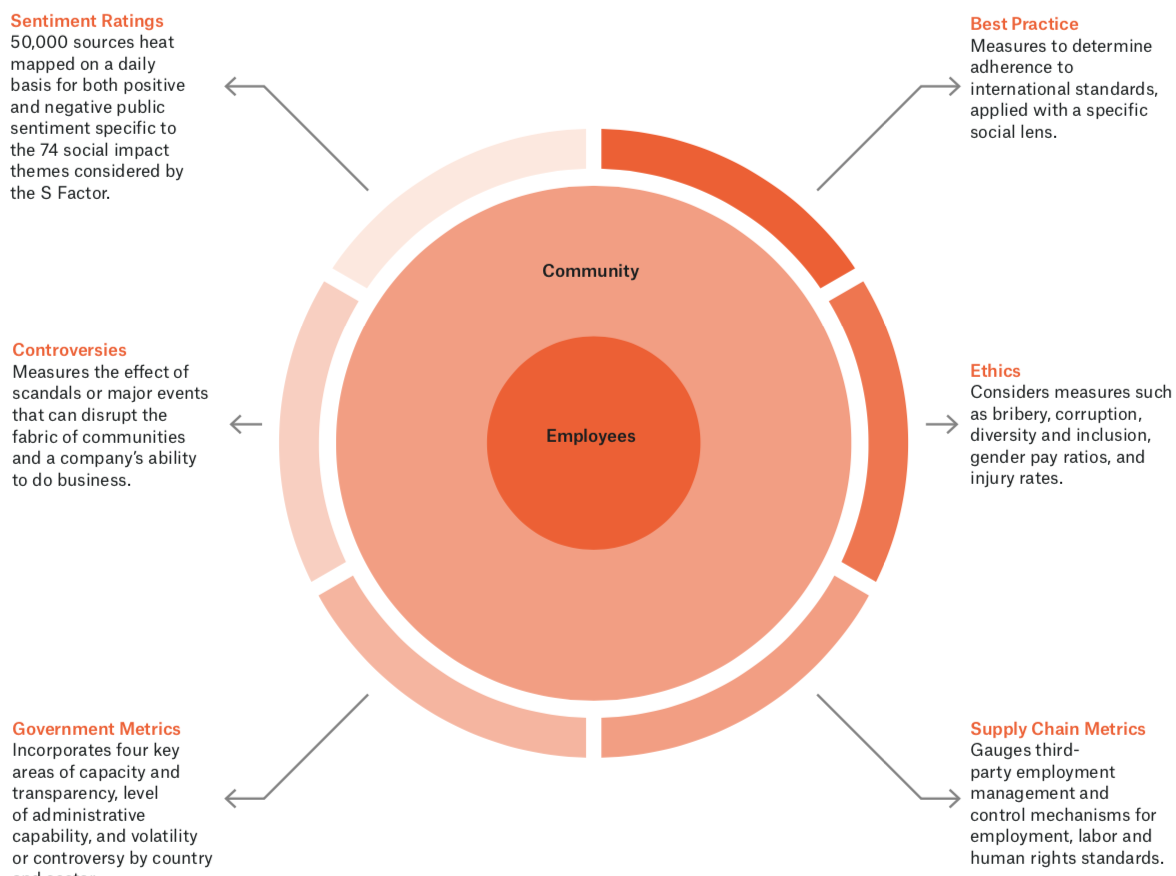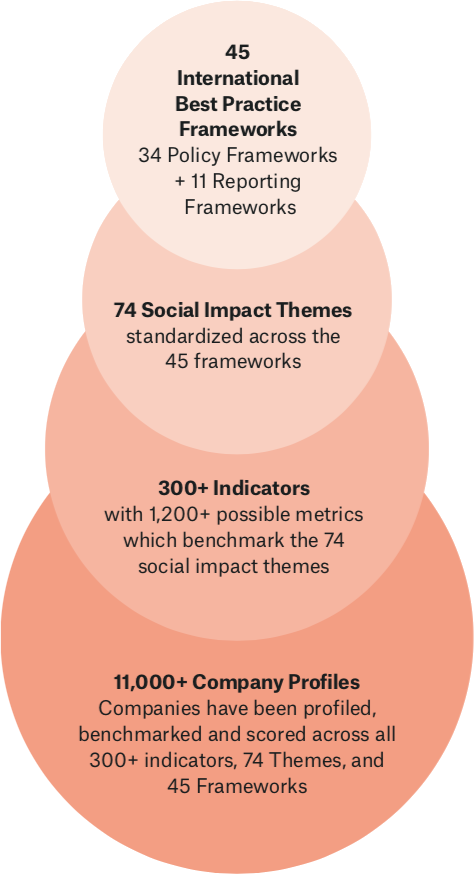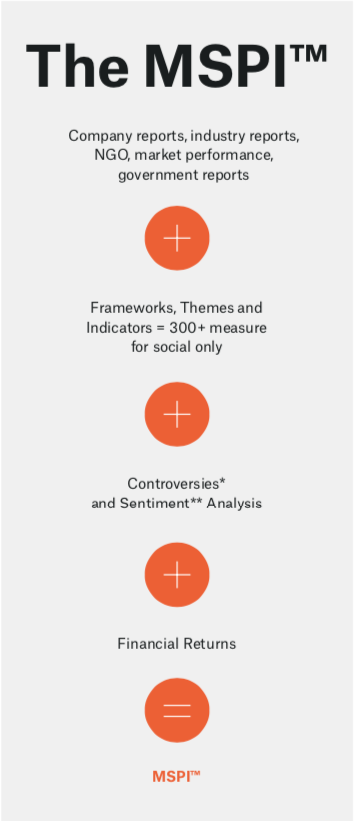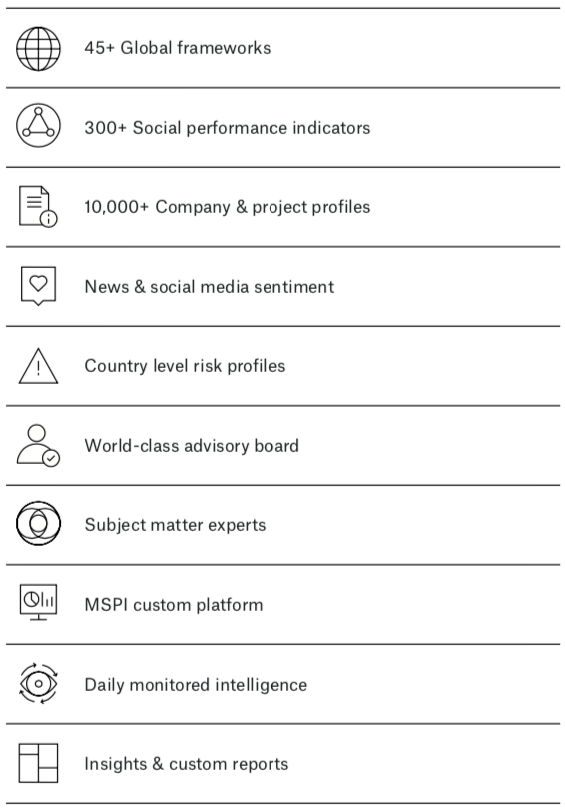We put the S in ESG.
Sustainable, Responsible and Impact investing (SRI) - an investment discipline which considers environmental, social and corporate governance (ESG) criteria to generate long-term competitive financial returns.
Learn MoreS Factor
The S Factors are the Social Factors, most of which are missing or are too “high-level” for current ESG considerations. The social impact factors are our area of subject-expertise, a discipline where we have been working boots-on-the-ground for over two decades specifically measuring social impacts.
The S Factor Co., is a MacCormick Inc. company, established in 2009. MacCormick created the World’s
First, Social Performance Index in 2010. Known as the MSPITM, it measures and benchmarks companies’ social impact and risk performance in accordance with dozens of frameworks and hundreds of indicators.
The S FactorTM Solution
The nucleus of the S Factor model measures individual companies’ socio-economic, socio- cultural and socio-political impact on people, starting with its employees in every location of operation, and incorporating the communities where it does business. The S Factor assesses metrics in these 6 core areas through the lens of the people, and correlates deep-dive analysis on ROI & SROI in relation to a variety of impacts in these areas.

Are companies doing more than they are simply required to do, because it’s the right thing to do?
Methodology, Compliance & Materiality
Each of our 300+ indicators may relate to several international frameworks and standards, of which there are thousands. The S Factor has standardized and simplified the metrics across multiple frameworks, making it faster and easier to access compliance or risk. For example:
Determining whether employees are “working excessive hours” may actually relate to several frameworks from non-related entities, such as: International Labour Standard (ILO); International Finance Corporation, Performance Standards (IFC, PS); United Nations Declaration on Human Rights (UNDHR)...and so on. There are many!
It is valuable to know how many frameworks you qualify for, as you may need to comply to several in various jurisdictions.
It is not enough for a company to publish a policy on each theme or topic. In order to truly measure impact - to qualify and to quantify it - they must demonstrate implementation with material evidence as well as ongoing monitoring and evaluation of performance. Qualifying statements must have third-party validation.
Our database covers
- 11,000+ companies,
- 74 social impact themes,
- 45 frameworks,
- 300+ social specific indicators and thousands of metrics.
Do companies understand how they impact people, and does it matter to them?
Results

Score
The S FactorTM score (“the score”) qualifies evidence of material information from multiple validated sources on a company’s social performance, data availability, and industry relevance. There are 4 possible scores associated with each of the 300+ indicators, each benchmarking hundreds of themes and indicators in accordance with dozens of frameworks.
The objective is to determine whether individual companies understand what social impact is, how to measure it, how to implement measures to mitigate their risks associated with it, and how to track and report on it – whether its required regulatory compliance or best-practice.

Index
The MSPITM considers the S FactorTM score plus controversies and public sentiment in its ranking of companies on social impact, by country, by industry, by theme and by indicator in correlation to financial performance. Companies in this ranking demonstrate a high S FactorTM score, positive public sentiment and superior financial returns. This deep- dive analysis allows you to quickly separate the best from the rest, ensuring that the companies doing well here are a class-above.
Ratings
While the MSPITM identifies the top performing companies, the information created by the S Factor modelling can also inform risk ratings as it relates to social issues, the probabilities of disruption, and the level of preparedness to manage uncertainties. The S FactorTM scores provide a well-rounded and comprehensive measure of a company’s social performance.
*Controversies: Include any scandals, disasters, litigation, disputes, or protest against the company, its operations, or investments. Controversies and sentiment are benchmarked on any or all of the S Factor score themes and weighted accordingly, resulting in an aggregated percentile.
** Sentiment: scans of 50,000 news and social media sites in 14 languages for both positive and negative sentiment on key themes; results are then blended with the controversy score for an aggregated percentile.
The S Factor’s information tools easily identify companies with strong social performance or exposure to social risks, allowing you to make well-informed, data- driven decisions.
Product features

ESG
- Ensure compliance with your policies
- Monitor and receive alerts when there is possible breach of your social impact Code of Conduct
- Understand the social impacts and risks associated with each sector
Impact
- Dispel impact-washing with the true-measure and true-cost of social impact
- Research and understand the social impact and risk challenges in the countries and sectors in which you invest or do business
Reporting
- Automatic compliance reporting
- Research social impact issues and trends to guide policy development and management strategy
- Track and benchmark your social impact and risk exposure against that of your peers